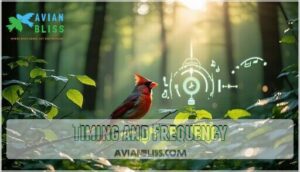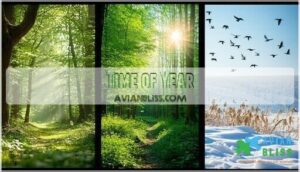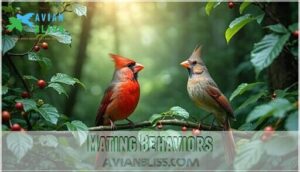This site is supported by our readers. We may earn a commission, at no cost to you, if you purchase through links.
 If you’re hearing a bird sounds like a whistle blowing, you’ve probably encountered one of nature’s most distinctive callers.
If you’re hearing a bird sounds like a whistle blowing, you’ve probably encountered one of nature’s most distinctive callers.
The White-throated Sparrow tops the list with its clear "Oh-sweet-Canada-Canada" whistle, while the Wood Thrush delivers flute-like notes that echo through forests.
Cardinals produce sharp, two-syllable whistles, and Northern Mockingbirds can mimic actual whistles they’ve heard.
These crisp calls aren’t random – birds use whistle-like sounds because they carry farther than complex songs, making them perfect for claiming territory or attracting mates.
The timing matters too, as most whistle calls happen during dawn, dusk, or breeding season when communication is essential for survival and reproduction.
Table Of Contents
- Key Takeaways
- Bird Call Identification
- Environmental Factors
- Mating Behaviors
- Frequently Asked Questions (FAQs)
- What bird sounds like a whistle blowing?
- How does a bird make a whistling sound?
- What birds make a whistle?
- What sounds do birds make?
- What does a flying bird sound like?
- What bird sounds like a whistle or a flute?
- What animal sounds like a whistle blowing?
- What kind of bird goes hoo hoo hoo?
- What bird mimics a whistle?
- What does it mean when a bird is whistling?
- Conclusion
Key Takeaways
- You’ll most likely hear a White-throated Sparrow producing that distinctive "Oh-sweet-Canada-Canada" whistle, though Cardinals, Wood Thrushes, and Northern Mockingbirds also create whistle-like sounds for territory marking and mate attraction.
- You can identify the specific bird by listening for key features like pitch patterns, rhythm, and tone quality – Cardinals produce sharp two-syllable whistles while Chickadees offer sweet "fee-bee" notes.
- You’ll hear these whistling calls most frequently during dawn and dusk, and breeding season when birds need to communicate for survival and reproduction, with calls typically lasting 1-3 seconds and repeating every 5-10 seconds.
- Your location and habitat significantly affect which whistling birds you’ll encounter – wetland areas feature American Wigeons, forests support Wood Thrushes and sparrows, while urban green spaces attract adaptable species like Cardinals and Mockingbirds.
Bird Call Identification
You’ll need to listen for specific features like pitch, rhythm, and tone quality to identify which bird species produces that whistle-like sound you’re hearing.
Pay attention to whether the call has multiple notes, repeats in patterns, or changes pitch, since these characteristics help distinguish between species like cardinals, chickadees, and killdeer.
Distinguishing Features
When identifying that bird whistle sound, focus on these distinguishing features: the call’s two-toned structure with alternating high and low pitches.
You’ll notice sound qualities resembling emergency sirens, lasting about one second each.
Species variation affects these distinct bird whistle patterns, while visual cues like habitat help narrow identification.
Some birds show remarkable mimicry ability in their whistling calls.
These sounds are important to avian survival and communication.
Timing and Frequency
You’ll notice whistling bird calls follow predictable patterns.
Most birds that make whistling sounds are most active during dawn and dusk when their call intervals are shortest.
Listen for whistle duration lasting 1-3 seconds with song repetition every 5-10 seconds.
Peak times occur during breeding season when frequency modulation becomes more complex and urgent.
Potential Species
You’ll frequently hear whistling bird calls from these common species in your area:
- American Wigeon – Males produce distinctive three-note whistles for Wigeon Identification during mating season
- Northern Cardinals – Create loud "what-cheer" whistles through advanced Syrinx Anatomy
- Black-capped Chickadees – Use "fee-bee" sounds for Avian Communication and Song Learning
- Killdeer – Sharp piercing whistles demonstrate natural Sound Mimicry abilities
Crested pigeons use whistling alarm signals produced by their feathers.
Environmental Factors
You’ll find that where you live, what habitat you’re in, and when you listen all affect which whistling birds you’ll encounter.
Different species prefer specific environments like wetlands or forests, and many only produce their distinctive calls during certain seasons or times of day, which can be considered as distinctive calls.
Location
Your whistle sound bird mystery depends heavily on where you’re hearing it.
Migration patterns shift species across regions seasonally, while regional dialects create unique variations in the same bird’s call.
Sound propagation differs between urban vs. rural environments – city noise masks softer calls, but amplifies piercing whistles.
Geography matters more than you’d think for whistling bird identification.
Climate change can cause migration route shifts, impacting which species are present.
Habitat
Different environments shape where you’ll encounter bird sounds like whistles.
The acoustic landscape of your backyard tells a story—every whistle reveals which feathered neighbors call it home.
Each habitat creates unique acoustic conditions that influence how these calls travel and which species you’ll discover.
Habitat types where whistling birds thrive:
- Wetland Habitats – American Wigeons and other waterfowl produce clear whistles
- Forested Areas – Dense vegetation dampens sound but supports diverse whistling species
- Grassland Regions – Open spaces amplify calls from meadowlarks and sparrows
- Urban Environments – Green spaces attract adaptable whistling birds despite noise pollution
- Migratory Routes – Seasonal corridors concentrate various whistling bird identification opportunities
Understanding local habitats helps predict which whistle sound bird species you’ll encounter in your area.
You can even find resources for identifying wetland calls online.
Time of Year
Seasonal variation dramatically affects which whistle like bird sounds you’ll encounter.
Spring brings migrating species through your area, while breeding season intensifies territorial calls.
Here’s what to expect:
- Migration Patterns: April-May features traveling warblers and thrushes with distinct whistling calls
- Breeding Season: June-July showcases male birds producing their loudest, most frequent whistle sounds
- Winter Silence: December-February offers fewer whistling bird species in most regions
Mating Behaviors
You’ll notice that whistling birds use their calls as powerful tools during mating season, with males producing distinctive sounds to attract females and establish territories.
These vocal displays aren’t just random noise—they’re calculated performances where pitch, rhythm, and timing can determine a bird’s success in finding a mate and defending prime nesting spots, which is a crucial aspect of their vocal displays.
Courtship Rituals
Looking at where birds choose to whistle gives you clues about their courtship rituals.
Male whistling birds perform elaborate display flights while producing mating calls to attract females.
Mate selection involves vocal duets between partners, with some species offering gift giving behaviors.
These bird call whistle performances strengthen pair bonding among whistle songbird species during breeding season.
Nesting Habits
Once courtship ends, whistle songbird pairs turn into dedicated home builders.
These feathered architects create cozy sanctuaries using remarkable precision:
- Nest materials include twigs, moss, and soft fur for ultimate comfort
- Nest location choices reveal hidden spots protecting precious cargo
- Nest building teamwork showcases incredible engineering skills
You’ll observe egg laying rituals followed by intensive chick development phases requiring constant parental attention.
Territorial Calls
After establishing their nests, birds shift into call aggression mode.
You’ll hear piercing territorial calls that sound like whistles, serving as boundary defense against intruders.
These bird sounds enable species recognition while extending signal range across neighborhoods.
Each threat response triggers intense bird communication, with mating calls doubling as warning sirens to protect their precious real estate.
To secure these resources, birds use aggressive behavior to ward off competition.
| Bird Species | Territorial Call Sound |
|---|---|
| Northern Cardinal | Sharp "what-cheer" whistle |
| American Robin | Loud "cheerily" phrases |
| Killdeer | Piercing "kill-deer" alarm |
| Chickadee | Rapid "fee-bee" trills |
| Meadowlark | Clear flute-like whistle |
Frequently Asked Questions (FAQs)
What bird sounds like a whistle blowing?
You’ll likely hear an American Wigeon making that distinctive whistle-blowing sound. Males produce a sharp, three-note nasal whistle that’s unmistakable during mating season and while communicating with their flock.
How does a bird make a whistling sound?
Birds create whistling sounds using their syrinx, a vocal organ where the trachea splits.
You’ll hear these sounds when vibrating membranes produce tones, while their beak shape acts like a whistle to amplify the noise.
What birds make a whistle?
Several species produce distinctive whistling calls you’ll recognize.
American Wigeons create three-note whistles, while Northern Cardinals belt out "what-cheer" phrases.
Chickadees offer sweet "fee-bee" notes, and Killdeer deliver piercing two-syllable calls that’ll grab your attention.
What sounds do birds make?
You’ll hear nature’s symphony everywhere—chirps, songs, calls, trills, whistles, caws, hoots, and chatters.
Each species creates unique sounds for communication, mating, territory defense, and alarm signals using their specialized vocal organs.
What does a flying bird sound like?
You’ll hear different sounds depending on the species.
Some make whistling calls, others produce wing-beats or rushing air sounds.
Ducks create whooshing noises, while smaller songbirds often stay quiet during flight.
What bird sounds like a whistle or a flute?
You’ll recognize the Northern Cardinal’s clear "what-cheer" whistle, the Wood Thrush’s haunting flute-like melody, or the Eastern Meadowlark’s high, sweet notes.
These songbirds create music that’ll make you stop and listen every time.
What animal sounds like a whistle blowing?
You’ll commonly hear American Wigeons producing sharp, three-note whistles that sound remarkably like someone blowing a referee’s whistle.
Cedar Waxwings and Northern Cardinals also create distinctive whistling calls that’ll catch your attention outdoors.
What kind of bird goes hoo hoo hoo?
You’re likely hearing a Great Horned Owl, which produces the classic "hoo-hoo-hoo" sound.
These nocturnal hunters use their deep, resonant calls to communicate with mates and defend territory throughout the night.
What bird mimics a whistle?
Like nature’s own copycat artist, the Northern Mockingbird stands out as the ultimate whistle mimic.
You’ll catch these talented performers copying car alarms, sirens, and various whistling sounds with remarkable accuracy throughout their impressive vocal repertoire.
What does it mean when a bird is whistling?
When you hear a bird whistling, it’s typically a male trying to attract a mate or defend his territory.
These musical calls serve as nature’s dating app and property alarm system rolled into one.
Conclusion
Like a detective solving a mystery, you’ve now learned to identify the distinctive whistle calls that echo through your neighborhood.
When you hear a bird sounds like a whistle blowing, you’ll know whether it’s a White-throated Sparrow’s sweet song or a Cardinal’s sharp call.
Pay attention to timing, location, and seasonal patterns to confirm your identification.
These whistling birds add beautiful music to our daily lives, and recognizing their calls connects you deeper with nature’s symphony surrounding you.
- https://www.pnt.org/
- https://www.scienceofbirds.com/blog/bird-songs
- https://bosshorn.com/blogs/blog/bird-sounds-like-a-whistle?srsltid=AfmBOoqYHJ59LAYb21cz9fj0hHn2bmAKsC_ZklG4i10uRRkRkNkwys5E
- https://bonairebirdtours.com/birding-by-ear-learn-how-on-bonaire/
- https://www.sciencedirect.com/science/article/pii/S0960982223008291










